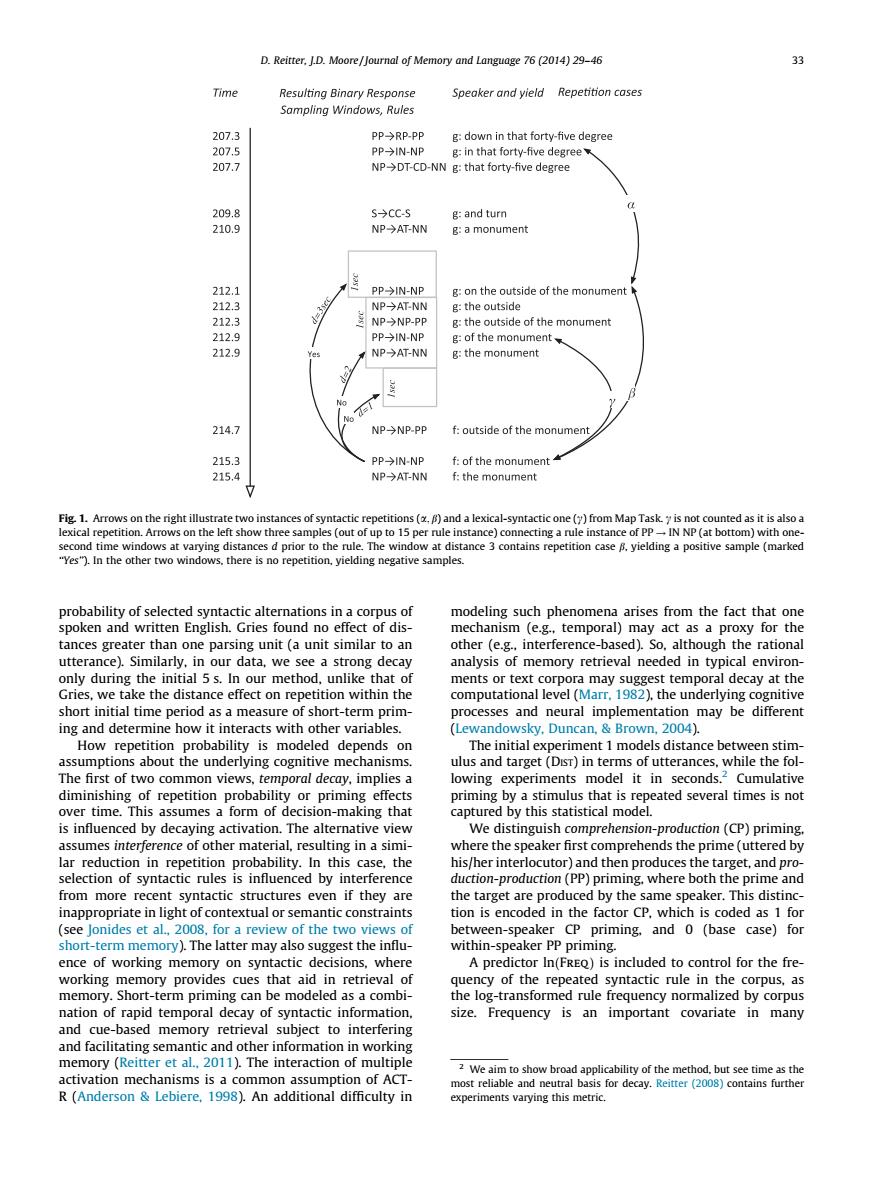正在加载图片...

D.Reitter.1.D.Moore/Journal of Memory and Language 76 (2014)29-46 33 Time Resulting Binary Response Speoker andyield Repetition cases Sampling Windows,Rule PP>RP-PP down in that forty-five degre g:and turn g:a monumen N.NE 212.9 NP→AT-N g:the monument 214, NP→NP-PP :outside of the monume NP ALNN FgLArowsoatheigtiustatewoinst cesof syntactic etit(and a lexical-syntacticne(from MapTask Th v of s uch phe as a prox tances gre er than one parsing unit(a unit similar to an e-D ased)so.alth only during the initial 5s. method,unlike that temporal decay a within the )the unde ngand determine howit interactswith other y.Duncan.Bro n2004. The first of views.tempral decay.implies a lowing experiments model it in seconds. Cumulativ is influenced by decaying activation.The alternative view We distinguish comprehension-production(CP)priming. other mate nhs加 the et and duction-rodcion()both th inapropiaitemlhtOfoteaoOrsnamc nstraints etween-speaker CP priming.and o(base case)for ence of working mem on svntactic decisions. A predictor n(R)is included to control for the fre provides 0 nation of rapid temporal decay of syntactic inform tion size Frequency is an important covariate in many subject to interfering memory (Reitter et al.2011).The interaction of multiple probability of selected syntactic alternations in a corpus of spoken and written English. Gries found no effect of distances greater than one parsing unit (a unit similar to an utterance). Similarly, in our data, we see a strong decay only during the initial 5 s. In our method, unlike that of Gries, we take the distance effect on repetition within the short initial time period as a measure of short-term priming and determine how it interacts with other variables. How repetition probability is modeled depends on assumptions about the underlying cognitive mechanisms. The first of two common views, temporal decay, implies a diminishing of repetition probability or priming effects over time. This assumes a form of decision-making that is influenced by decaying activation. The alternative view assumes interference of other material, resulting in a similar reduction in repetition probability. In this case, the selection of syntactic rules is influenced by interference from more recent syntactic structures even if they are inappropriate in light of contextual or semantic constraints (see Jonides et al., 2008, for a review of the two views of short-term memory). The latter may also suggest the influence of working memory on syntactic decisions, where working memory provides cues that aid in retrieval of memory. Short-term priming can be modeled as a combination of rapid temporal decay of syntactic information, and cue-based memory retrieval subject to interfering and facilitating semantic and other information in working memory (Reitter et al., 2011). The interaction of multiple activation mechanisms is a common assumption of ACTR (Anderson & Lebiere, 1998). An additional difficulty in modeling such phenomena arises from the fact that one mechanism (e.g., temporal) may act as a proxy for the other (e.g., interference-based). So, although the rational analysis of memory retrieval needed in typical environments or text corpora may suggest temporal decay at the computational level (Marr, 1982), the underlying cognitive processes and neural implementation may be different (Lewandowsky, Duncan, & Brown, 2004). The initial experiment 1 models distance between stimulus and target (DIST) in terms of utterances, while the following experiments model it in seconds.2 Cumulative priming by a stimulus that is repeated several times is not captured by this statistical model. We distinguish comprehension-production (CP) priming, where the speaker first comprehends the prime (uttered by his/her interlocutor) and then produces the target, and production-production (PP) priming, where both the prime and the target are produced by the same speaker. This distinction is encoded in the factor CP, which is coded as 1 for between-speaker CP priming, and 0 (base case) for within-speaker PP priming. A predictor lnðFreqÞ is included to control for the frequency of the repeated syntactic rule in the corpus, as the log-transformed rule frequency normalized by corpus size. Frequency is an important covariate in many Fig. 1. Arrows on the right illustrate two instances of syntactic repetitions (a; b) and a lexical-syntactic one (c) from Map Task. c is not counted as it is also a lexical repetition. Arrows on the left show three samples (out of up to 15 per rule instance) connecting a rule instance of PP ! IN NP (at bottom) with onesecond time windows at varying distances d prior to the rule. The window at distance 3 contains repetition case b, yielding a positive sample (marked ‘‘Yes’’). In the other two windows, there is no repetition, yielding negative samples. 2 We aim to show broad applicability of the method, but see time as the most reliable and neutral basis for decay. Reitter (2008) contains further experiments varying this metric. D. Reitter, J.D. Moore / Journal of Memory and Language 76 (2014) 29–46 33